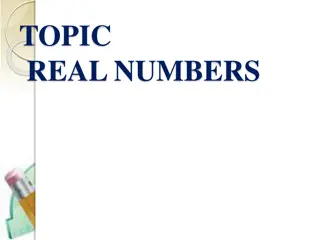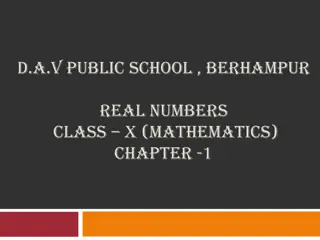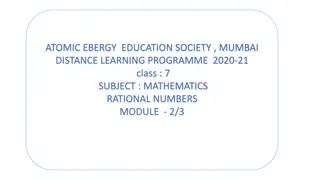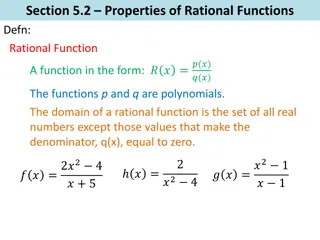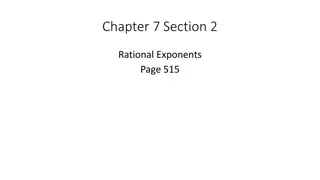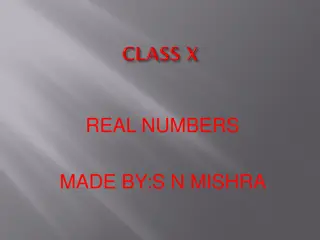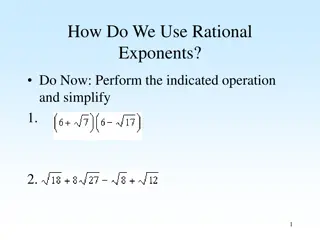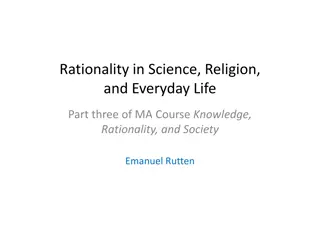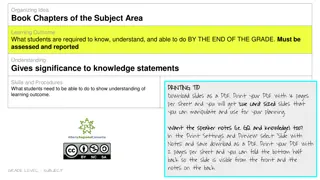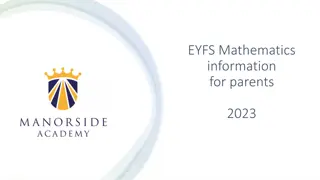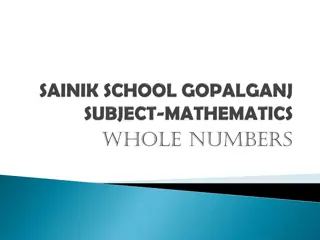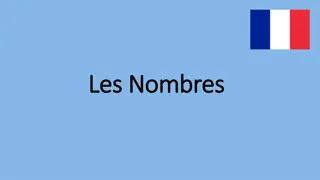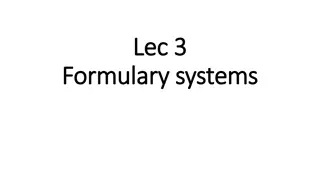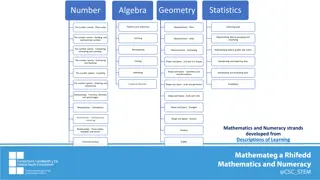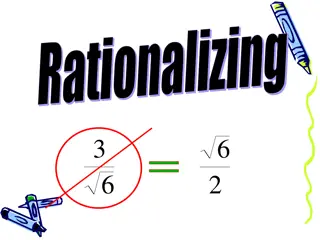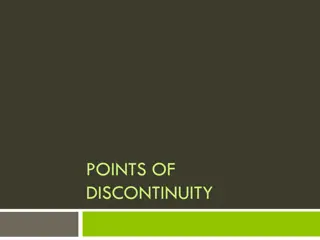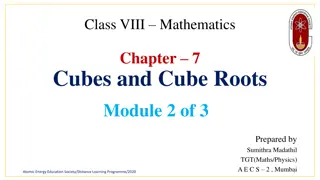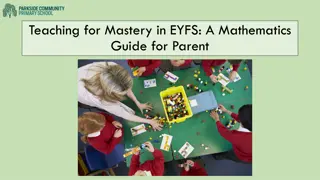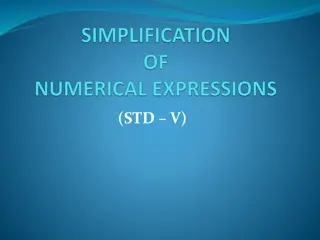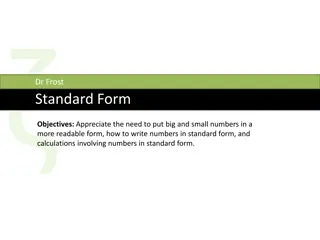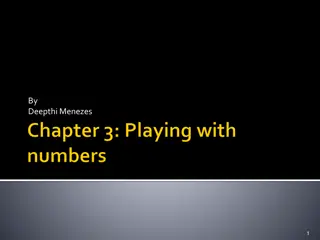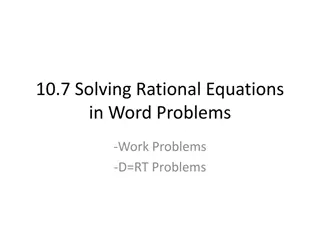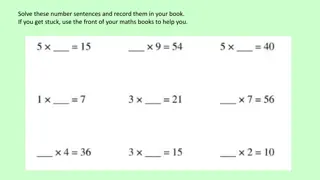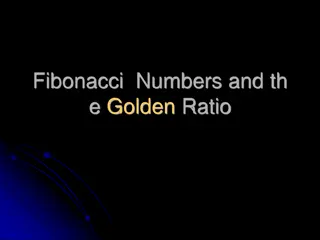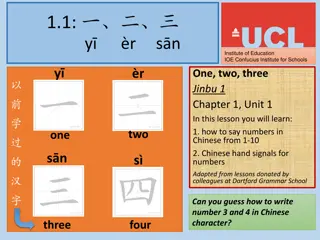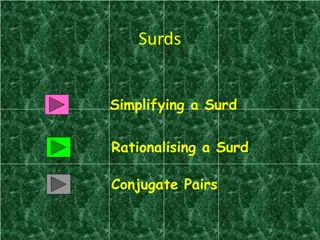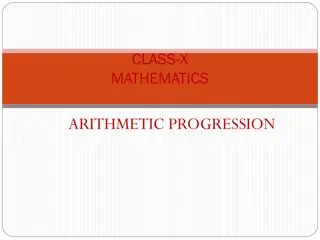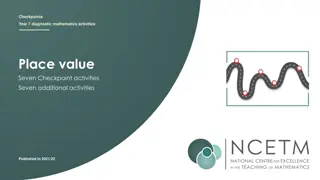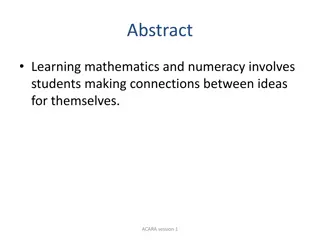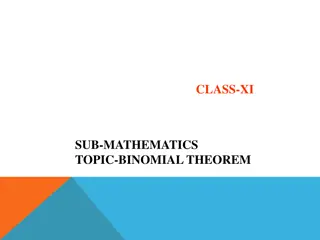Understanding Rational and Irrational Numbers in Mathematics
Explore the concept of rational and irrational numbers in mathematics through defining, distinguishing, computing, representing, and rationalizing these types of numbers. Learn about natural numbers, whole numbers, integers, rational numbers, and irrational numbers with clear examples. Answer common questions regarding the relationship between these number types. Delve into the significance of number systems for higher-level studies.
Download Presentation

Please find below an Image/Link to download the presentation.
The content on the website is provided AS IS for your information and personal use only. It may not be sold, licensed, or shared on other websites without obtaining consent from the author. Download presentation by click this link. If you encounter any issues during the download, it is possible that the publisher has removed the file from their server.
E N D
Presentation Transcript
DAV INSTITUTIONS ,ODISHA ZONE-1 CLASS-IX DAV PUBLIC SCHOOL,POKHARIPUT,BHUBANESWAR MATHS DERARTMENT OF MATHEMATICS
Learning Objectives The Students will be able to Extend their concept beyond integers and define Rational and Irrational numbers. Distinguish Rational numbers from natural numbers, whole numbers and integers. Compute n numbers of Rational numbers between any two given rational numbers. Diagrammatically represent irrational numbers on the number line. Formulate various ways of rationalization of irrational numbers. Apply the laws of exponents as per the requirements. Appraise the use of number system in higher level of study.
Natural (N) Whole (W) Integers (Z) Rational (Q) Irrational (s) Try to define these terms with examples.
RATIONAL NUMBER A number r is called a rational number, if it can be written in the form ? ?,? ??? ? ??? ? ??? ???????? ??? ? 0 For example- -75 can be written in the form 75 p q 1 We know that the rational numbers do not have a unique representation in the form ? ?,? ??? ? ??? ? ??? ???????? ??? ? 0. For example-1 2=2 4=10 20=25 30=47 94,??? ?? ?? . These are equivalent rational numbers.
Once we are able to define the types of numbers, let us try to answer these questions: Is every whole number a natural number? Is every integer a rational number? Is every natural number a whole number? Is every whole number an integer? Is every rational number a natural number? Is every rational number a whole number ? Is every rational number an integer? Is every whole number a rational number?
Is it difficult to answer? To answer these questions easily, look at the table done below. Rational number Integers Whole nos. n n Natural nos.
How many rational numbers lies between two rational nos? Ans. There are infinitely many rational numbers between any two given rational numbers. But how?? To find a rational number between two rational numbers(a and b),we can add a and b and divide the sum by 2,that is ?+? 2 ???? ??????? ? ??? ?. 2,5 For example rational nos. between 1 and 2 are 3 4,11 8,13 8,7 4, .
There is another way too to find rational nos. between two rational numbers. Suppose the question is to find five rational nos. between 1 and 2. As we want five numbers ,we write 1 and 2 as rational nos. with denominator 5+1,i.e. 1 =6 6 ??? 2 =12 6,10 6 6. Then the nos. are 7 6,8 6,9 6,11 Or else try to make the denominators equivalent. Like,1 =10 10???2 =20 10,? ?? ? ? ???.???11 20,12 20, ..19 20
WORKSHEET:1 Is 0 a rational number ? justify. Find six rational numbers between 3 and 4. Find five rational numbers between 3 5 ???4 5
IRRATIONAL NUMBERS A number s is called irrational, if it cannot be written in the form ? ?,? ??? ? ??? ? ??? ???????? ??? ? 0 As we know there are infinitely many rational numbers ,in turn that are also infinitely many irrational numbers too. Now the collection of rational and irrational numbers are known as REAL NUMBERS(R) Therefore, a real number is either rational or irrational. So, every real number is represented by a unique point on the number line. Also, every point on the number line represents a unique real number known as real number line.
DIFFERENCE BETWEEN RATIONAL AND IRRATIONAL NUMBERS
Representing irrational numbers on the number line. Can use Pythagoras theorem to represent irrationals on the number line. Onto the number line take the vertex O coincides with zero. Take OA as 1 unit in length and OB as 1 unit, then by Pythagoras theorem OB= 12+ 12= 2. Using compass with centre O and radius OB, draw an arc intersecting the number line at the point P. Then P corresponds to 2 on the number line. Similarly, 3 can be represented on the no.line by taking the base as 2units and perpendicular 1 unit.
Another way to represent irrationals on the number line Show how 5 can be represented on the number line. Draw a line segment AB=5 cm. From B, mark BC=1 cm. Now, draw the perpendicular bisector of AC and mark the bisector point as O. Draw a semicircle taking OA as radius. Draw a line perpendicular to AC through B and intersecting the semi circle at D. Then ?? = 5 units. Now draw a no. line and cut an arc length of BD from 0, which represents 5 on the no. line.
The Square Root Spiral ( or Wheel of Theodorus or Einstein Spiral or Wurzel Spirale ) is a very interesting geometrical structure, in which the square roots of all natural numbers have a clear defined spatial orientation to each other
ART INTEGRATION https://youtu.be/M6R68nqa38A
WORKSHEET-2 Locate square root of 2,3,5,6,7 on the number line. Construct the square root spiral till square root of 10.
Real numbers and their decimal expansions Decimal expansion of rational number is either terminating or non-terminating repeating expansion and vice versa. Ex-0.54,1.444444 ..,4.565656 . Decimal expansion of irrational number is non-terminating non-repeating expansion and vice versa Ex-1.02002000200002 .,34.778887778887777 .. NOTE- Let ? =? where ? ??? ? ??? ??? ???????? ????????. ? be a rational number, such that the prime factorisation of q is of the form 2?5?, Then ? has a decimal expansion which terminates. And if prime factorisation of q is not of the form 2?5?, then ? has a decimal expansion which is non- terminating repeating.
Find four irrational numbers between the rational numbers 5 7 ??? 9 11 5 7= 0.7142857142 ??? As we know the decimal expansion of irrational numbers is non terminating non repeating ,the four irrational numbers between the given numbers are 9 11= 0.818181 0.727227222722227 . 0.747447444744447 0.808008000800008 0.797997999799997 ..
Solve these questions: Show that 1.272727 .can be expressed in the form of ? ? ,? ??? ? ??? ? ??? ???????? ??? ? 0. Ans- Let ? = 1.272727 . Since two digits are repeating ,we multiply ? by 100 to get 100? = 127.272727 . Therefore, 100? ? = 127.272727 . 1.272727 ..= 126 99? = 126 Therefore, ? =126 11 99=14
Show that 0.2353535can be expressed in the form ? ?where ? ??? ? ??? ???????? ??? ? 0. Let ? = 0.23535 . Look here, 2 does not repeat, but the block 35 repeats. So, we can multiply ? by 10 to get 10? = 2.353535 .. 1 And now can multiply ? ?? 1000 ?? ??? 1000? = 235.3535 (2) Subtracting (1) from (2) we get, 990? = 233 Therefore, ? =233 990
WORKSHEET-3 Express the following in the form ? ?,? ??? ? ??? ? ??? ???????? ??? ? 0 0.6 0.477777 .. 1.234444 .. 0.001001001 . 0.99999 ..
Operations on Real Numbers The sum of a rational and an irrational number is irrational. The difference of a rational and an irrational number is irrational. The quotient of a non-zero rational number with an irrational number is irrational. The product of a non-zero rational number with an irrational number is irrational. The sum of two irrational numbers may be rational or irrational. The difference of two irrational numbers may be rational or irrational. The product of two irrational numbers may be rational or irrational. The quotient of two irrational numbers may be rational or irrational.
The statement we have seen in the last slide, now we will justify with examples. 2 + 5 ???????? + ?????????? = ?????????? 3 2 ???????? ?????????? = ?????????? 4 5 2= 2 5 ?????????? ???????? = ?????????? 4 3 3 = 12 3 ???????? ?????????? = ?????????? 2 3 + 3 = 3 3 ?????????? + ?????????? = ?????????? 2 3 + 3 = 2 (?????????? + ?????????? = ????????)
2 3 3 = 3 ?????????? ?????????? = ?????????? 2 + 3 3 = 2 (????????? ?????????? = ????????) 3 3 = 3 (????????? ?????????? = ????????) 6(????????? ?????????? = ??????????) 2 3 = 6 5 3 5= 2(????????? ?????????? = ????????) 8 15 2 5= 4 3(????????? ?????????? = ??????????) The same way give some more examples for each.
Rationalising the denominator The rationalising factor of 1 2 is 2.(1 2 2= 2 2 2) 1 2+ 2 2 2 1 2 2 = 2 2 The rationalising factor of 2+ 2 is 2 2.( 2) 1 7 3 5 7+3 5 1 The rationalising factor of 7 3 5 is 7 + 3 5.( 7+3 5 = 7+3 5 4 ) 1 1 7 7= 7 The rationalising factor of 3 7 ?? 7. 3 7 21 The rationalising factor of 2+ 3 7 3 5 is 7 + 3 5 (7 3 5)(7+3 5)=2 7+3 5 + 3(7+3 5) 2+ 3 7 3 5 7+3 5 7+3 5=(2+ 3)(7+3 5) =14+6 5+7 3+3 15 72 (3 5)2 4
WORKSHEET-4 Rationalise the denominators of the following: 1 7 3 5 6 5 2+5 7 1 7 5 3+ 7 5 3
Laws of exponents for real numbers 1 ? We define ?? = ? ?,? ??? ? ??? ? ? ??????? ???.? ??? ? ?? ? ? ???? ??? ? ??? ? ??? ? ? ?????????. ?? ??= ??+? ?? ??= ?? ? (??)?=??? WORKSHEET-5 1 2 1 5 64 ????=(??)? EVALUATE: 32 ?0=1 1 3 1 5 125 2 32 1 517 1 ??= ? ? 2 1 5 13
WORSHEET(BASIC) TIME-45 Min MAX.MARKS:20 1.Choose the correct option: (2 X1=2) Every rational number is a. natural number b. an integer c. a real number d. a whole number Between two rational numbers a. There is no rational number c. There are infinitely many rational number b. There is exactly one rational number. d. there only rational numbers and no irrational numbers. 2. Fill in the blanks: (2 X1=2) The decimal expansion of 7 is __________ The only even prime number is ___ 3. Answer the following: (2 X1=2) Find an irrational number between 1 2 7 7 ??? 1 Find the rationalising factor for 3+ 5
4. Short Answer Type Question I (2 X 2=4) Express 0.125 in the form of ? ? where ? ??? ? ??? ???????? ??? ? 0. Locate 3 on the number line. 5. Short Answer Type Question II (2 X 3=6) If ? = 2 + 3 ,???? ? ? ????? ?? ? 1 ? 1 4 + 364+ (256 25 1 Simplify 625) 2 3 (64 125) 6. Long answer type question: (1 X 4= 4) Evaluate 2+1+ ----------------------------------------------------------------------------------------------- 1 1 1 1 3+ 2+ 4+ 3+ + 9+ 8
WORSHEET(STANDARD) TIME-45 Min MAX.MARKS:20 1. Choose the correct option: (2 X1=2) A rational number between 2??? 3 is 3+ 2 2 3 2 2 a. b. 1.52 c. 1.92 d. Decimal expansion of a rational number cannot be a. Terminating b. non- terminating c. non- terminating repeating d. non- terminating non- repeating 2. Fill in the blanks: (2 X1=2) 32 42 1232 is ____________ The product of 112 80 20 28 is ___________ The value of 3. Answer the following: (2 X1=2) Is product of two irrational numbers always irrational? Justify? 33 ?? 44 ????????? Which is greater
4. Short Answer Type Question I (2X 2=4) 3216+15 3 2) 532 + 225 481 8 Simplify Simplify (256) (4 5. Short Answer Type Question II (2X 3=6) Locate 3 5 on the number line. 1 If ? = 3 + 2 2,? ?? ???? ? ? ????? ?? ?3+ ?3 6. Long answer type question: (1 X 4= 4) 7+ 5 7 5+7 5 7 11 Find the value of ? ??? ? 7+ 5= ? + 5? ------------------------------------------------------------------------
WORSHEET(ADVANCE) TIME-45 Min MAX.MARKS:20 1. Choose the correct option: (2 X1=2) The value of 2.999 . in the form of ? ? ? ??? ? ??? ? ??? ???????? ??? ? 0,?? a. 2999 1000 b. 19 10 c. 3 d. 26 9 5 32 is equal to The value of 1 10 d. 3 10 1 a. 310 b. 3 10 c. 3 2. Fill in the blanks: (2 X1=2) The value of 4 3+5 2 48+ 18?? __________ 3625 4 340 + 3 3320 is _________ The value of 2 3. Answer the following: (2 X1=2) If ? = ?2?,? = ?2?,? = ?2?,???? ? ? ????? ?? ??? Show that: ??(? ?) ??(? ?) (?? ??)?=1
4. Short Answer Type Question I (2X 2=4) 1 If ? = 9 4 5,???? ? ? ????? ?? ? ? 1 ?+1 ?+1 If 2?= 3?= 6 ?,????? ? ?? ?= 0 5. Short Answer Type Question II (2X 3=6) Find the value of 2( 2+ 6) 3 2+ 3 5+2 5+1 + 5 2 Find the value of 5+1 6. Long answer type question: (1 X 4= 4) 1 2 3,???? ? ? ????? ?? ?3 2?2 7? + 4 --------------------------------------------------------------------- If ? =



